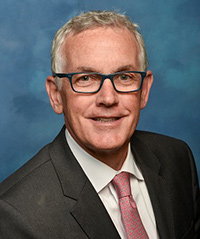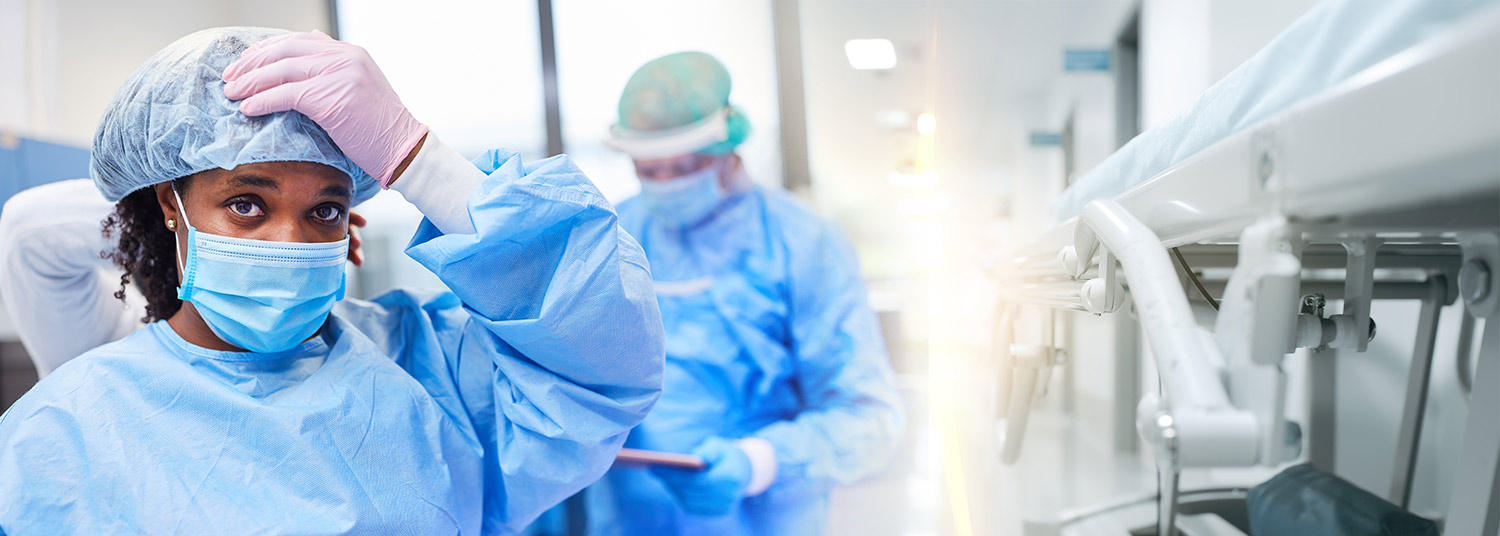August 11, 2021 | Deborah Kotz
Use of New Preparedness Tool Can Help Hospitals Determine Their Ability to Respond to Unexpected Surges Due to Mass Shootings, Terrorist Attacks, or Future Pandemics

“Our work links objective healthcare data to a hospital score that assesses the ability to save lives in a disaster,” said study lead author David Marcozzi, MD, Professor of Emergency Medicine at UMSOM and Chief Clinical Officer/Senior Vice President at UMMC. “It attempts to fill a glaring gap in the national conversation on the need for improved assessments of and the opportunity for better hospital planning to assure readiness.”
To conduct the research, Dr. Marcozzi, who is also the COVID-19 Incident Commander for the University of Maryland Medical System / University of Maryland, Baltimore / University of Maryland School of Medicine, and his colleagues first developed and published a surge index tool that linked standard reported hospital information to healthcare preparedness elements. The tool, called the Hospital Medical Surge Preparedness Index (HMSPI), used data from 2005 to 2014 to produce a score designed to predict how well a hospital can handle a sudden influx in patients due to a mass shooting or infectious disease outbreak. Such data included the size of the medical staff, the number of hospital beds, and the amount of equipment and supplies.

Medical surge capacity is an important measure to assess a hospital’s ability to expand quickly beyond normal services to meet an increased demand for healthcare. The Las Vegas mass shooting in 2017, for example, sent more than 500 concertgoers to local hospitals. During the early weeks of the COVID-19 pandemic, New York City hospitals were under siege with 4,000 patients hospitalized. To calculate the HMSPI, researchers input data from four important metrics.
- Staff: Doctors, nurses, pharmacists, respiratory technicians and others
- Supplies: Personal protective equipment, cardiac monitors, sterile bandages, and ventilators
- Space: Total beds and number of beds that current staff can handle
- Systems: Framework for enabling electronic sharing of files and information between departments and multiple hospitals
In the new study, Dr. Marcozzi and his colleagues used data from the American Hospital Association’s annual surveys of more than 6,200 hospitals nationwide that were collected from 2005 to 2014. They also employed data from the U.S. Census Bureau to determine population estimates in cities and the Dartmouth Atlas Project to establish the geographic service area of each hospital. They combined the hospital metrics gleaned from the AHA’s annual surveys with the geographic data to calculate HMSPI composite scores for hospitals in each state.
Their evaluation found varying levels of increases in HMSPI scores from 2005 to 2014 in every state, which could indicate that states are becoming better prepared to handle a medical surge. The scores also indicated that ideal readiness had not yet been achieved in any state before the COVID-19 pandemic.
“This is just the starting point. We need to better understand the ability of our nation’s hospitals to save lives in times of crisis,” said Dr. Marcozzi. This information, and follow-up studies building from this work, will be key to better matching states’ healthcare resources to their population to assure optimal care is delivered. Dr. Marcozzi described one follow-up study that would be impactful would be to use data from the COVID-19 pandemic to see whether the index was predictive to indicate which hospitals were most prepared for the pandemic surge based on their patient outcomes.
“This pioneering work is a needed advancement that could allow for a transparent assessment of a hospital’s ability to save lives in a large-scale emergency," Dr. Marcozzi said. "The COVID-19 pandemic demonstrated that there is still plenty of room for improvement in the ability of our nation’s healthcare system to triage and manage multiple patients in a crisis and that translates into lives lost, unnecessarily. Our research is dedicated to those who lost their lives in this tragedy and other mass casualty events. We can do better.”


“The COVID-19 pandemic taught us that we need to be better prepared for the unexpected crisis,” said E. Albert Reece, MD, PhD, MBA, Executive Vice President for Medical Affairs, UM Baltimore, and the John Z. and Akiko K. Bowers Distinguished Professor and Dean, University of Maryland School of Medicine. “Having an important metric like the HMSPI could be a game changer that ultimately saves lives during a surge by helping hospitals identify and fix their vulnerabilities.”
About the University of Maryland School of Medicine
Now in its third century, the University of Maryland School of Medicine was chartered in 1807 as the first public medical school in the United States. It continues today as one of the fastest growing, top-tier biomedical research enterprises in the world -- with 46 academic departments, centers, institutes, and programs, and a faculty of more than 3,000 physicians, scientists, and allied health professionals, including members of the National Academy of Medicine and the National Academy of Sciences, and a distinguished two-time winner of the Albert E. Lasker Award in Medical Research. With an operating budget of more than $1.2 billion, the School of Medicine works closely in partnership with the University of Maryland Medical Center and Medical System to provide research-intensive, academic and clinically based care for nearly 2 million patients each year. The School of Medicine has nearly $600 million in extramural funding, with most of its academic departments highly ranked among all medical schools in the nation in research funding. As one of the seven professional schools that make up the University of Maryland, Baltimore campus, the School of Medicine has a total population of nearly 9,000 faculty and staff, including 2,500 students, trainees, residents, and fellows. The combined School of Medicine and Medical System (“University of Maryland Medicine”) has an annual budget of over $6 billion and an economic impact of nearly $20 billion on the state and local community. The School of Medicine, which ranks as the 8th highest among public medical schools in research productivity (according to the Association of American Medical Colleges profile) is an innovator in translational medicine, with 606 active patents and 52 start-up companies. In the latest U.S. News & World Report ranking of the Best Medical Schools, published in 2021, the UM School of Medicine is ranked #9 among the 92 public medical schools in the U.S., and in the top 15 percent (#27) of all 192 public and private U.S. medical schools. The School of Medicine works locally, nationally, and globally, with research and treatment facilities in 36 countries around the world. Visit medschool.umaryland.edu
About the University of Maryland Medical Center
The University of Maryland Medical Center (UMMC) is comprised of two hospital campuses in Baltimore: the 800-bed flagship institution of the 13-hospital University of Maryland Medical System (UMMS) — and the 200-bed UMMC Midtown Campus, both academic medical centers training physicians and health professionals and pursuing research and innovation to improve health. UMMC’s downtown campus is a national and regional referral center for trauma, cancer care, neurosciences, advanced cardiovascular care, women's and children's health, and has one of the largest solid organ transplant programs in the country. All physicians on staff at the downtown campus are clinical faculty physicians of the University of Maryland School of Medicine. The UMMC Midtown Campus medical staff is predominately faculty physicians specializing in diabetes, chronic diseases, behavioral health, long term acute care and an array of outpatient primary care and specialty services. UMMC Midtown has been a teaching hospital for 140 years and is located one mile away from the downtown campus. For more information, visit www.umm.edu.
About the University of Maryland Medical System
The University of Maryland Medical System (UMMS) is a university-based regional health care system focused on serving the health care needs of Maryland, bringing innovation, discovery and research to the care we provide and educating the state's future physician and health care professionals through our partnership with the University of Maryland School of Medicine and University of Maryland, Baltimore professional schools (Nursing, Pharmacy, Social Work and Dentistry) in Baltimore. As one of the largest private employers in the State, the health system's more than 29,500 employees and 4,000 affiliated physicians provide primary and specialty care in more than 150 locations, including 13 hospitals and 9 University of Maryland Urgent Care centers. The UMMS flagship academic campus, the University of Maryland Medical Center in downtown Baltimore, is recognized regionally and nationally for excellence and innovation in specialized care. Our acute care and specialty rehabilitation hospitals serve urban, suburban and rural communities and are located in 13 counties across the State. For more information, visit www.umms.org.
Contact
Deborah Kotz
University of Maryland Medicine
dkotz@som.umaryland.edu
(410) 706-4255

